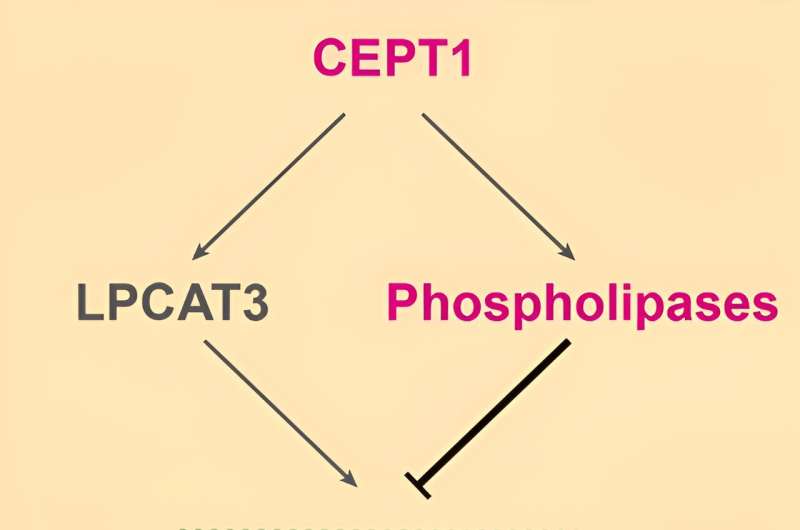This article has been reviewed according to Science X's editorial process and policies. Editors have highlighted the following attributes while ensuring the content's credibility:
fact-checked
proofread
Study reveals previously unrecognized role of CEPT1 in suppressing ferroptosis

Ferroptosis is distinct from other forms of cell death due to its reliance on iron and lipid peroxidation. A recent study characterizes the protein interaction landscape for ferroptosis pathways through proteomic analysis, identifies CEPT1 as an LPCAT3-interacting protein, and demonstrates that CEPT1 suppresses ferroptosis by interacting with phospholipases and breaking down certain pro-ferroptotic polyunsaturated fatty acid (PUFA)-containing phospholipids.
The work titled "Proteomic analysis of ferroptosis pathways reveals a role of CEPT1 in suppressing ferroptosis" was published in Protein & Cell.
Key findings from the study include:
- The study created HEK-293T cells expressing tagged proteins involved in ferroptosis, identifying 182 high-confidence interacting proteins (HCIPs). This network highlighted significant interactions relevant to lipid biosynthesis, mitochondrial biogenesis, membrane trafficking, and nucleocytoplasmic transport.
- LPCAT3 formed the most extensive interaction network among the studied proteins, indicating its central regulatory role. LPCAT3's interactions included proteins involved in lipid metabolism and intracellular transport, suggesting a broader functional implication in ferroptosis regulation.
- CEPT1 was identified as an LPCAT3-interacting protein. Further experiments showed that CEPT1 stabilizes LPCAT3 by preventing its lysosomal degradation, thus maintaining LPCAT3 levels crucial for phospholipid synthesis.
- Contrary to expectations, CEPT1 deletion sensitized cells to ferroptosis inducers, while its overexpression suppressed ferroptosis. In vivo experiments confirmed that CEPT1 deletion made tumors more susceptible to ferroptosis inducers, supporting its role in ferroptosis suppression.
The study reveals that CEPT1, traditionally known for its role in phospholipid synthesis, plays a critical role in suppressing ferroptosis by stabilizing LPCAT3 and facilitating the breakdown of pro-ferroptotic lipids.
These findings provide new insights into the regulatory mechanisms of ferroptosis, highlighting CEPT1 as a potential target for therapeutic intervention in diseases associated with ferroptosis dysregulation.
By establishing a comprehensive protein interaction landscape, the research underscores the complexity and significance of proteomic approaches in understanding ferroptosis pathways and developing targeted treatments.
More information: Xiaoguang Liu et al, Proteomic analysis of ferroptosis pathways reveals a role of CEPT1 in suppressing ferroptosis, Protein & Cell (2024). DOI: 10.1093/procel/pwae004
Provided by Frontiers Journals





















